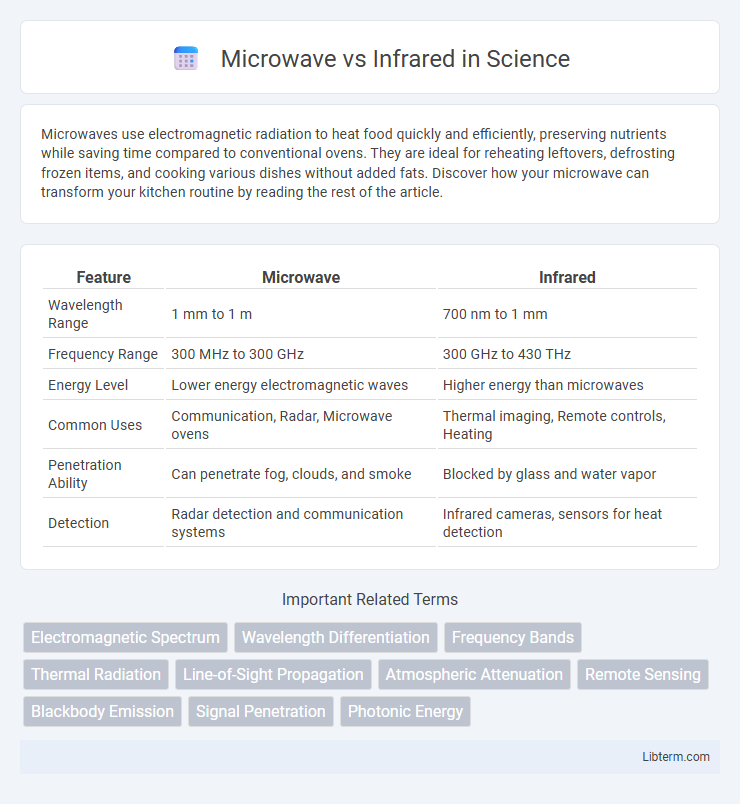Microwaves use electromagnetic radiation to heat food quickly and efficiently, preserving nutrients while saving time compared to conventional ovens. They are ideal for reheating leftovers, defrosting frozen items, and cooking various dishes without added fats. Discover how your microwave can transform your kitchen routine by reading the rest of the article.
Table of Comparison
| Feature | Microwave | Infrared |
|---|---|---|
| Wavelength Range | 1 mm to 1 m | 700 nm to 1 mm |
| Frequency Range | 300 MHz to 300 GHz | 300 GHz to 430 THz |
| Energy Level | Lower energy electromagnetic waves | Higher energy than microwaves |
| Common Uses | Communication, Radar, Microwave ovens | Thermal imaging, Remote controls, Heating |
| Penetration Ability | Can penetrate fog, clouds, and smoke | Blocked by glass and water vapor |
| Detection | Radar detection and communication systems | Infrared cameras, sensors for heat detection |
Introduction to Microwave and Infrared Technologies
Microwave technology uses electromagnetic waves with frequencies ranging from 300 MHz to 300 GHz, enabling wireless communication, radar systems, and cooking applications due to its ability to penetrate materials and excite water molecules. Infrared technology operates in the wavelength range of approximately 700 nm to 1 mm, commonly utilized in remote controls, thermal imaging, and short-range communication by detecting heat emitted from objects. Both technologies exploit different parts of the electromagnetic spectrum, with microwaves focused on longer wavelengths for volume penetration and infrared on shorter wavelengths for surface-level heat sensing.
Basic Principles: How Microwave and Infrared Work
Microwaves operate using electromagnetic waves with frequencies typically between 300 MHz and 300 GHz, causing water molecules in food to vibrate and generate heat through dielectric heating. Infrared radiation, with wavelengths longer than visible light but shorter than microwaves, transfers heat by exciting molecular vibrations in the surface layers of materials, relying on thermal radiation. Both technologies use electromagnetic energy but differ in wavelength and heating mechanisms, affecting penetration depth and heating uniformity.
Key Differences Between Microwave and Infrared
Microwaves have longer wavelengths ranging from one millimeter to one meter, while infrared waves have shorter wavelengths between 700 nanometers and 1 millimeter. Microwaves penetrate materials such as food and plastics for heating, whereas infrared waves primarily transfer heat through surface radiation and are used in applications like thermal imaging. Frequency ranges also differ, with microwaves operating between 300 MHz and 300 GHz compared to infrared frequencies ranging from 300 GHz to 430 THz.
Applications of Microwave Technology
Microwave technology is extensively used in telecommunications for satellite and radar systems, providing reliable long-distance signal transmission and detection capabilities. It plays a crucial role in medical treatments, such as diathermy and certain cancer therapies, by targeting tissues with precise electromagnetic energy. Industrial applications include microwave drying and heating processes, which offer efficient and uniform heating compared to conventional methods.
Applications of Infrared Technology
Infrared technology is widely applied in remote controls, thermal imaging cameras, and night vision devices due to its ability to detect heat radiation. It plays a crucial role in medical diagnostics, such as infrared thermography for detecting inflammation or blood flow abnormalities. Industrial applications include non-contact temperature measurement and moisture detection, enhancing safety and efficiency in manufacturing processes.
Advantages of Microwave Systems
Microwave systems offer advantages such as longer transmission distances and better penetration through atmospheric conditions like rain and fog, making them highly reliable for telecommunications and radar applications. They support higher data rates and can efficiently handle large bandwidths, enhancing communication quality and speed. Microwave technology also enables point-to-point communication with minimal interference, ensuring secure and stable data transmission.
Advantages of Infrared Systems
Infrared systems offer advantages such as higher energy efficiency and the ability to provide focused, localized heating without warming the surrounding air, making them ideal for precise applications. Infrared radiation penetrates surfaces to deliver uniform heat quickly, enhancing cooking speed and preserving moisture in food. These systems also operate quietly and safely, with minimal electromagnetic interference compared to microwave technology.
Limitations and Challenges of Microwave and Infrared
Microwave technology faces limitations such as signal attenuation due to atmospheric conditions like rain and obstacles, which can degrade communication quality and distance. Infrared systems struggle with line-of-sight requirements and are highly susceptible to interference from ambient light sources, limiting their usability in outdoor or brightly lit environments. Both technologies encounter challenges in penetrating solid objects, affecting their performance in obstructed or complex settings.
Safety Considerations: Microwave vs Infrared
Microwave radiation used in cooking devices operates at frequencies that can cause dielectric heating and potential burns if exposure limits are exceeded, but proper shielding and safety standards minimize risks. Infrared radiation primarily causes surface heating and poses lower penetration hazards, reducing the risk of internal tissue damage but still requiring caution to avoid skin burns or eye injury. Both technologies mandate adherence to regulatory exposure limits set by organizations such as the FDA and ICNIRP to ensure safe usage and prevent health complications.
Choosing the Right Technology: Microwave or Infrared
Choosing between microwave and infrared technology depends on the specific application requirements such as penetration depth, wavelength, and environmental conditions. Microwaves offer superior penetration through obstacles like fog or walls, making them ideal for long-range communication and radar systems, while infrared excels in short-range applications including remote controls and thermal imaging due to its higher frequency and sensitivity to temperature variations. Consider factors like signal attenuation, range, and interference when selecting the optimal technology for efficient performance and reliability.
Microwave Infographic

 libterm.com
libterm.com